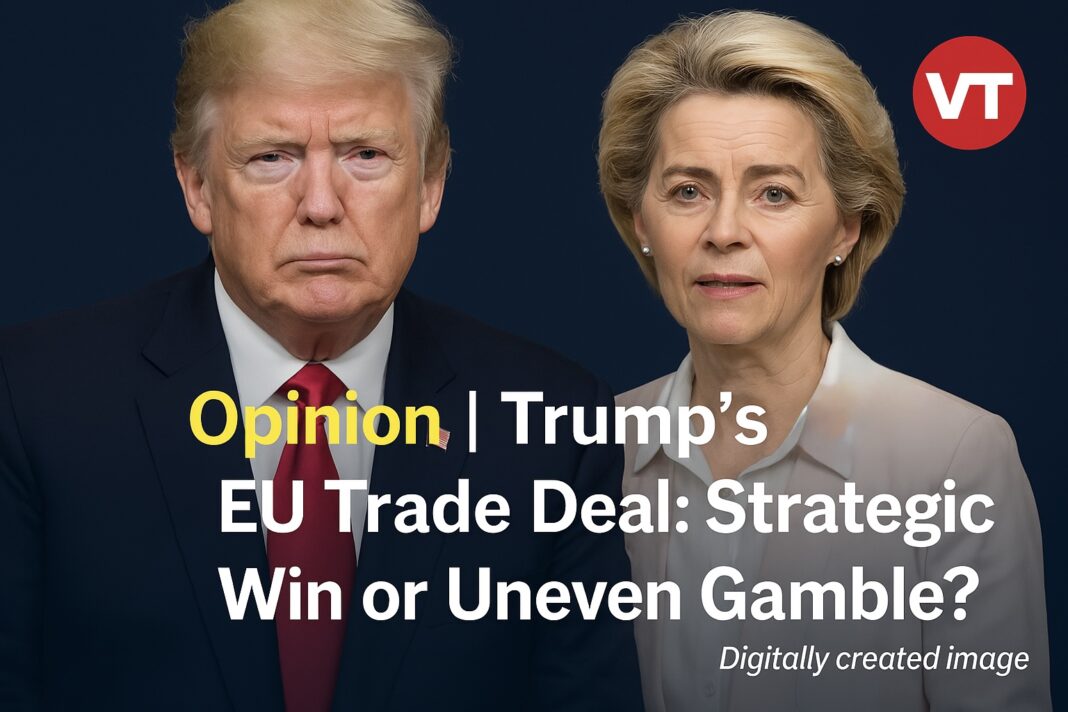- Trump issued a formal tariff warning to the EU on July 11, setting an August 1 deadline for action.
- The deal, announced July 27 in Scotland, imposes a 15% flat tariff on EU exports to the U.S.
- EU committed to $750B in U.S. energy purchases and $600B in U.S. infrastructure investment.
- U.S. exports to the EU will face zero tariffs under a new zero-for-zero framework.
The Big Picture
On July 11, 2025, President Donald J. Trump sent a formal letter to European Commission President Ursula von der Leyen, warning that the United States would impose a 30% tariff on EU goods beginning August 1 unless new terms were agreed. The letter cited “persistent trade deficits” and “non-reciprocal tariffs” as justification for immediate action.
With that deadline looming, the two leaders met at Trump’s Turnberry resort in Scotland on July 27 and announced a breakthrough. The agreement imposes a 15% flat tariff on most EU imports, while offering zero tariffs on strategic U.S. exports. In exchange, the EU committed to massive purchases of U.S. energy and major investments in American infrastructure and defense industries.
What’s New
Based on the official EU statement, the finalized trade agreement between the United States and the European Union includes the following key provisions:
- Tariffs: A flat 15% tariff will apply to the majority of EU exports to the United States, including automobiles, semiconductors, and pharmaceuticals. This rate is described as “all-inclusive” and non-stacking.
- Zero-for-zero: The agreement introduces zero tariffs on strategic U.S. exports to the EU, including aircraft and component parts, certain chemicals, generics, semiconductor equipment, agricultural products, and critical raw materials.
- Energy purchases: The EU has committed to significant purchases of U.S. energy products — including LNG, oil, and nuclear fuels — as part of its transition away from Russian energy dependence.
- Investment: European institutions and private sector actors will invest approximately $600 billion in U.S. infrastructure, clean energy, and defense manufacturing projects over the next three years.
- Steel & Aluminum: While 50% tariffs remain, both parties agreed to implement a quota system and begin work on reducing barriers through fair competition frameworks addressing global overcapacity.
This framework is designed to provide stability for transatlantic trade, reinforce energy security, and support industrial cooperation between the two largest economies in the world.
What They’re Saying
President Trump called it “a Landmark Trade Deal with the European Union.”
Ursula von der Leyen echoed:
And nearly 44 percent of global GDP.
It’s the biggest trade deal ever.”
In her official European Commission statement, von der Leyen emphasized the economic and political magnitude of the pact:
We stabilized on a 15% all-inclusive tariff for most EU exports—providing clarity for businesses. We agreed on zero-for-zero tariffs for aircraft, chemicals, semiconductor equipment, and raw materials. Energy purchases will replace Russian supply with U.S. LNG and nuclear fuels. This agreement ensures access to our largest export market while boosting competitiveness and reducing barriers. A true foreign economic policy begins here.
🇩🇪 Germany Reacts
Chancellor Friedrich Merz welcomed the outcome:
🚗 Auto Sector Hit Hard
Volkswagen absorbed significant losses:
- US News confirmed a €1.3B ($1.5B) loss in H1 2025, forcing revised guidance.
- TechStory reported that Porsche profits plunged 90% and Audi dropped 64%.
Mercedes-Benz is bracing for hikes:
- Mercedes-Benz U.S. dealers are keeping 2025 prices steady “until further notice.”
- Its Tuscaloosa, Alabama plant, which builds 35% of U.S. vehicles, provides some shielding, per US News.
Strategic Win or Uneven Gamble?
President Trump’s EU trade agreement may be one of the boldest exercises in economic brinkmanship in recent history. By issuing a direct tariff ultimatum and negotiating from a position of pressure, Trump secured concessions that many U.S. presidents could only have hoped for. American energy, defense, and industrial sectors now stand to benefit from a steady wave of European demand and investment.
But while the deal is being celebrated in Washington, it comes with mixed reviews in Brussels and Berlin. The EU’s unity held, but its leverage was tested. Germany’s cautious praise and the visible impact on its auto industry suggest that the benefits are not equally distributed.
Whether this agreement signals a lasting shift in U.S.–EU relations—or simply a pause before another standoff—remains to be seen. The strategy worked for now, but its sustainability depends on mutual enforcement, regulatory alignment, and how well both economies can weather its side effects. It’s a strategic win, yes—but whether it becomes a long-term success or an uneven gamble depends on what both sides do next.
Follow Virginia Times for regular news updates. Stay informed with the latest headlines, breaking stories, and in-depth reporting from around the world.
Freelance Writer














